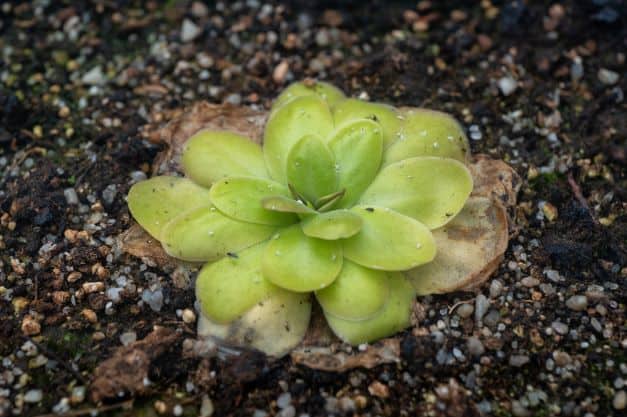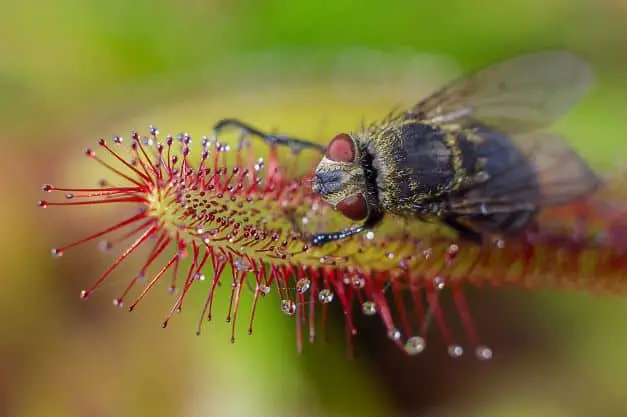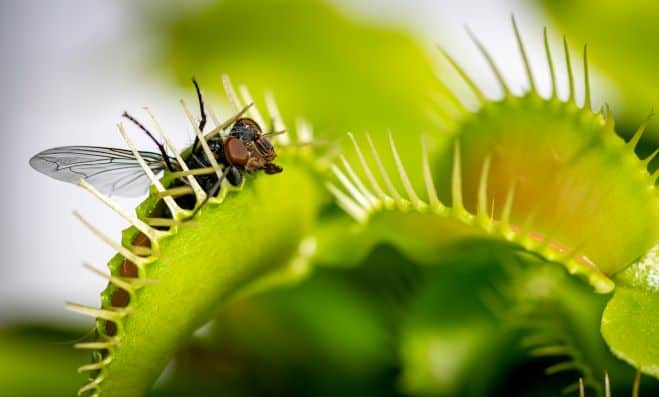Some people who don’t even like plants keep a carnivorous plant, just because such plants are that cool. The most popular carnivorous plant species kept at home is called the Venus flytrap (Dionaea muscipula), but many more species of plants are feeding on living things.
The 5 Carnivorous plant types include Bladder Trap in the genus Utricularia, Flypaper type has genus Drosera, Pinguicula, among others. Lobster-pot type with its single genus, Genlisea, Pitfall type includes the genus Nepenthaceae, Sarraceniaceae, Cephalotaceae, and Bromeliaceae. The last plant type is the Snap, which has only two plant species – the Venus flytrap (Dionaea muscipula), and the waterwheel plant (Aldrovanda vesiculosa).
If you’re looking to purchase a carnivorous plant and want to know which species to get, or simply want to learn about the different types of carnivorous plants, we recommend you read through this article.
The Different Carnivorous Plant Types
It’s possible to categorize carnivorous plants by the genus they belong to, but genera are always being disputed and differences between some aren’t that clear and obvious. That’s why it’s best to sort carnivorous plants by the trapping mechanism they use:
| Type | Mechanism | Genus/Genera | # of Species |
| Bladder | Vacuum Suction | Utricularia | ~230 |
| Flypaper | Sticky Mucilage | Byblis Dionaea Drosophyllum Triphyophyllum Pinguicula | 270+ |
| Lobster-Pot | Trichomes – Inward Pointing Hairs | Genlisea | ~30 |
| Pitfall | Curved Leaves Covered With Wax | Brocchinia Catopsis Cephalotus Darlingtonia Heliamphora Sarracenia Nepenthes | 220+ |
| Snap | Thigmonasty – Closing Leaves Shut | Aldrovanda Dionaea | 2 |
There are also several species that use combination traps which use mechanisms of two separate types, like Drosera glanduligera or pimpernel sundew that has traps with flypaper and snap trap features or some species in Nepenthes genus (e.g., N. inermis, N. Dubia, N. flava) that have traps with features of both, flypaper and pitfall type traps.
Bladder Type Trap Carnivorous Plants
Plants that have this type of trapping mechanism are called bladderworts and belong to a single genus called Utricularia, consisting of over 230 species. It’s the biggest and most spread out carnivorous plant genus, growing in all continents except Antarctica.
Bladderworts are among the most complex plants and have developed a highly specialized structure that’s unlike any other plant. They don’t have a root system, and their vegetative organs are difficult to distinguish, following a uniform shape.
The only traits bladderworts share with other plants are having flowers and being capable of photosynthesis to produce energy. They’re considered carnivorous because they have traps that are often compared to bladders due to containing water and being shaped like bladders.
These bladders are always submerged under the substrate, whether water or soil, as bladderworts grow in both. The traps vary in size from as tiny as 0.008 in (0.2 mm) in terrestrial species, to as big as 0.47 in (1.19 cm) in aquatic species.
The traps are purely mechanical and get triggered without any irritability or reaction from the plant, unlike those of other carnivorous plants in genera like Aldrovanda, Dionaea, or Drosera.
Bladder traps work by active transport, when water from the inside is being pumped outside through the trap walls creating negative pressure inside, bending the walls inward. The trap’s valve is hinged on a lever, which activates the trap once the prey steps on it.
When it happens, the doors open and accumulated pressure inside sucks in the water in front, together with the animal which activated the trap. It also closes the valve, and the plant starts digesting the prey.
This entire sequence of trap activation, suction, and valve opening and closing takes just 1/100 of a second! It makes bladderworts the fastest moving plants in the world, and the trap gets reactivated in 15 to 30 minutes.
Terrestrial species feed on microscopic single-cell protozoa, while aquatic bladderworts feed on much larger prey including mosquito and fish larvae, eelworms, and even tadpoles.
One of the most popular species of this plant to grow at home is called Sanderson’s bladderwort (Utricularia sandersonii). It originated in South Africa, but doesn’t require a lot of care and can grow in temperate climates, resulting in its popularity. Sanderson’s bladderwort grows up to 20 in (50.8 cm) in height and spread, reaching full size in about 2 years.
Flypaper Trap Type Carnivorous Plants
This type of trap has sweet mucilage or glue on its surface which attracts, traps, and asphyxiates the prey before it gets digested and absorbed by the plant. Scientists think that flypaper traps are an example of convergent evolution and have evolved independently at least 5 times. It suggests that such a mechanism of trapping is extremely efficient for carnivorous plants.
There are 5 genera with plants utilizing flypaper traps, the biggest being Drosera or sundews. It consists of over 190 carnivorous species growing on all continents except Antarctica. The sundews have growing tentacles capable of movement, and some species can bend their tentacles towards the prey for as much as 180 degrees in just under 30 minutes!
The second-biggest genus is Pinguicula, commonly called butterworts. There are about 80 species, most of which grow in South America, and about 10 each in North America and Europe.

Their traps are their leaves which range between 1 and 12 in (2.54 and 30.48 cm) in length and are covered with two types of glands, one for secreting trapping mucilage and the other for digesting the pretty.
Interestingly, the butterworts can use the secretory glands just once, meaning the area of the trap that has once caught and digested a prey won’t be effective for the second time.
The third-biggest genus of flypaper plants is Byblis, commonly known as rainbow plants. There are just 8 distinct species, growing only in Australia and New Guinea. They are split into two complexes, with annual species in Byblis liniflora complex and perennial species in Byblis gigantea complex.
Annual rainbow plants vary in height from 5.9 to 19.7 in (15.24-50 cm) and leaf length from 1.6 to 5.9 in (4-15 cm), and perennial species grow up to 28 in (71 cm) tall and have leaves that can reach 7.9 in (20 cm) in length.
Finally, the remaining 2 flypaper genera are Drosophyllum and Triphyophyllum, both of which have a single species, the former growing in the Mediterranean region, and the latter in western Africa.
Lobster-Pot Trap Type Carnivorous Plants
Genlisea is the only genus of plants that have lobster-pot type traps. There are about 30 species, which are commonly called the corkscrew plants. They grow in Africa, and Central and South America, and can be found in semi-aquatic environments.
The corkscrews are very genetically diverse and show a wide variety of phenotypic traits, but all of them have corkscrew-like traps. They work by having an opening that allows the prey, specifically protozoa, to enter it freely, but not allowing it to leave thanks to inward-pointing hair. The hair leads the prey deeper towards the enlargement at the stalk, sometimes called “stomach”, where it gets digested by enzymes.
Enzymes differ from species to species, but phosphatase is the one that is found in all known species. Strangely enough, the carnivorous nature of corkscrew plants was proven relatively recently, in 1998, despite being known by Charles Darwin more than 100 years prior.
One of the most popular corkscrew species among carnivorous plant hobbyists is called creeping snowberry (Gaultheria hispidula), which is an evergreen shrub that produces light green flowers bearing white berries in late summer and early autumn.
Pitfall Type Trap Type Carnivorous Plants
This type of trap is the most widespread among carnivorous plant families and is utilized by hundreds of plants found in 7 genera. It works by attracting the prey (ranging from insects to small mammals) with sweet nectar and bright colors, making it fall inside the trap (called pitcher) where it’s asphyxiated by the nectar.
It has convergently evolved at least 6 times, meaning it’s one of the most efficient types of carnivorous plant traps. That’s also the reason why it’s found in 4 plant families, while other types of traps are found in just 1 or 2 families.
The biggest family is Nepenthaceae and has a single genus Nepenthes which includes over 170 species commonly called monkey cups or the Old World pitcher plants. The first name comes from monkeys drinking water from the traps, and the second because they grow in the Old World, including Africa, Asia, and Europe.
Nepenthes are climbers and have pitchers at the end of their tendrils. The vast majority of these plants secrete wax-like substances on the inner side of their traps, which make the prey slip and fall into the pool of nectar at the bottom.
The second-biggest family is Sarraceniaceae, or New World pitcher plants. It includes three genera; Sarracenia or North American pitcher plants with about 10 species, Heliamphora or sun pitchers with 23 species, all growing in South America, and Darlingtonia with a single species named California pitcher plant.
Carnivorous plants in this family differ from the Old World pitcher plants because their entire leaves make up the pitcher, compared to just the portion of a tendril in Nepenthaceae family plants.
The third family that has pitfall-type traps is Cephalotaceae, which has a single genus with a single species commonly called Albany pitcher plant. It grows just in a small area in Southwestern Australia and has pitchers that grow up to 2 in (5.08 cm) in size.
Finally, the fourth family with pitchers is Bromeliaceae, which has 75 genera, but only 2 of those, Brocchinia and Catopsis contain carnivorous plants, the former 2 species, and the later 1 species.
Snap Type Trap Carnivorous Plants
There are only two plant species that have snap-type traps – the Venus flytrap (Dionaea muscipula), and the waterwheel plant (Aldrovanda vesiculosa). Interestingly, both species belong to different genera but have evolved from the same common ancestor from the lineage of flypaper-type plants.
Venus flytrap is possibly the most popular carnivorous plant that’s grown at home. That’s the plant that pops into everyone’s mind when the words “carnivorous plant” is being said. It naturally grows in bogs and wet savannas found in South Carolina and North Carolina, but can be easily grown in most places around the world.
Its name comes from the Latin words mus (mouse) and decipula (trap), because its traps resemble mouse traps, if not by appearance then by the mechanism of action. The size of traps varies from cultivar to cultivar, but usually are about 1.5 in (3.81 cm) in diameter.
The plant itself grows up to 12 in (30 cm) in height and 9 in (22.86 cm) in width and has 4 to 7 leaves that end in two lobes each, making a trap. The traps have trigger hairs, which have to be touched for the trap to shut, either one hair twice in rapid succession, or two hairs separately in a span of about 20 seconds.
One study found that the diet of Venus flytraps in nature consists of 33% ants, 30% spiders, 10% beetles, 10% grasshoppers, 5% flying insects, and the rest of other animals, including bugs and slugs. It’s speculated that the Venus flytrap diverged from its flypaper ancestors that use sticky mucilage because it allowed them to eat bigger prey, which is more energy-efficient.
Venus flytraps have digestive enzymes which help them digest their prey in about 10 days, after which the traps reopen and start waiting for the new prey.
Another plant that has snap-type traps is the waterwheel plant, which is found in some parts of Africa, Asia, Australia, and Europe. It doesn’t have roots and grows in water, consisting of stems that can reach 16 in (40.64 cm) in length.
Its common name comes from the fact that traps grow around the main stem in what’s called whorled leaf arrangement. Each whorl has between 5 and 9 traps that are 1⁄16–1⁄8 in (2-3 mm) long, allowing the plant to trap only the smallest of animals, including daphnia, eelworms, and mosquito larvae.
Each trap has 4 to 6 bristles that can reach up to ⅜ in (9.5 mm) in length. They protect the traps from closing accidentally by blocking floating debris from activating the trap. Talking about the activation, the traps of the waterwheel plant also have trigger hairs, which have to be touched for the trap to shut close. The traps close down in just about 100 milliseconds or 0.1 seconds, making it one of the quickest rapid movements found in plants.
There are some concerns about this species going extinct, as there are only 50 populations growing in the wild, but it doesn’t stop carnivorous plant hobbyists from growing it at home.
Frequently Asked Questions (FAQ)
(Q): What Is The Biggest Carnivorous Plant Species?
(A): Nepenthes rajah is the biggest carnivorous plant species. This 5 feet (152 cm) tall plant uses a pitfall-type trapping mechanism and has pitchers that can reach 16 in (41 cm) in height, 7.8 in (20 cm) in width, and hold over 3 quarts of water and over 2 quarts of digestive fluid.
(Q): What To Feed Carnivorous Plants?
(A): The food you should give to your carnivorous plants varies from species to species, but there are specific products, like food gels, that are designed for multiple plant species, consisting of all the necessary nutrients like minerals and vitamins for plants to grow healthy.
Final Words
As you just read, carnivorous plants are a wide family of plants consisting of many genera and species. We hope this article helped you understand what types of carnivorous plants there are. We wish you all the best in growing your favorite carnivorous plant!





